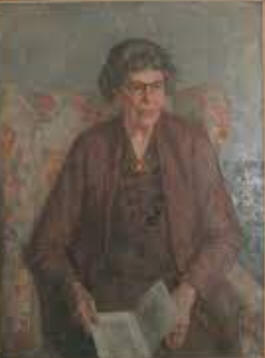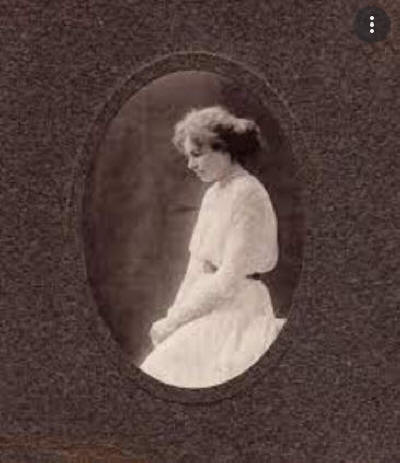

Partner Eglantyne Jebb
Queer Places:
16 Bishopswood Rd, Highgate, London N6 4NY, UK
The Flat, 11A Chaucer Rd, Cambridge CB2 7EB, UK
Cambridge City Crematorium
Girton, South Cambridgeshire District, Cambridgeshire, England
 Margaret
Neville Keynes Hill (February 4, 1885 - June 22, 1970) was the ‘strikingly
beautiful’ sister of the famous economist
John Maynard Keynes.
Margaret
Neville Keynes Hill (February 4, 1885 - June 22, 1970) was the ‘strikingly
beautiful’ sister of the famous economist
John Maynard Keynes.
Eglantyne Jebb, founder of Save the Children, declared herself unable to live without Margaret Keynes, whom she met while working for the Charity Organization Society: ‘Whatever happens, I am yours,’ wrote Jebb: ‘[Y]our face is the most beautiful one in the world and the nicest to kiss and kiss’. The two women left a voluminous, 20-year correspondence: ‘My sweetheart, I have had no letter from you today,’ Margaret complained at Christmas 1910. They arranged to share a bed whenever possible, and Margaret, with two bisexual brothers, would have been no stranger to such shared-sex intimacies, which in her and Eglantyne’s case covered the discussion of a joint house and a ‘marriage’. Eventually, however, Margaret was persuaded to marry a man, and she went on to have four children, to whom Eglantyne, no personal lover of children, despite her diligent international work for them, declared she didn’t wish to be an ‘auntie’.
Margaret Hill was born on February 4, 1885, in Cambridge into a family brimming over with achievements. Her father, John Neville Keynes, was a prominent figure at Cambridge University lecturing in moral sciences as well as being an eminent author of books on formal logic and political economy. Her mother, Florence, herself a Cambridge graduate, was highly active in local government and charities and became the very first female member of Cambridge Borough Council and, at 70, the city’s first mayor. Her elder brother, John Maynard Keynes, was the most famous economist of the 20th century and was awarded a hereditary peerage. Her younger brother, Geoffrey Keynes, was given a knighthood for his work on blood transfusion whilst a surgeon at St Bartholomew’s.

The Flat, 11A Chaucer Rd, Cambridge
The Gem was a children's magazine produced by the Keynes family, under the editorship of Margaret Neville Keynes and including contributions from her brothers John Maynard and Geoffrey Keynes. The Gem was first produced on 7 January 1898, and ran to 11 numbers, before it became The Acorn in 1899. The editions contain stories, poems, editorials, and pen and watercolour drawings.
Margaret married a notable academic, Archibald Vivien Hill, who was awarded the Nobel Prize for Physiology and Medicine. But of all these luminaries, it was Margaret who left the wonderful legacy that still lives on today as Hill Homes. Margaret and Archibald moved to Highgate in 1923 and Margaret wasted no time at all before getting heavily involved in community voluntary work. She conceived a system of bringing home help to confined mothers that now exists all over the UK. In 1929 she was elected onto Hornsey Council, following her mother’s footprints, and set up the Hornsey Housing Trust. She managed homes requisitioned for the use of elderly war victims, and in 1940 opened Highgate Homes for Aged War Victims in Highgate Lane. When this quickly became full and she needed more space, Margaret managed to the empty Highgate School Sanatorium in just two days, having it up and running two weeks later.
In March 1944 it was announced that all the Highgate Homes would be de-requisitioned after the war but Margaret was not having it. She felt it was morally wrong that these elderly people, who had grown accustomed to and familiar with their homes, should have to face the upheaval of moving. And so on D Day, 6 June 1944, Hill Homes came into existence with its very first meeting. This was held at Margaret’s house at 16 Bishopswood Road; finding themselves unable to buy the Highgate Homes, they decided to purchase 14 Bishopswood Road and 2 Broadlands Road, now the site of “Trees”.
Between 1945 and 1947 Margaret and Hill Homes went on to buy three more properties in Highgate including one at 22 Shepherds Hill which is now Nuffield Lodge. Before the end of the decade Hill Homes was acclaimed not just nationally but internationally, but Margaret was only just beginning. Her next aim was to help the mentally frail elderly that Hill Homes was not equipped to look after and so in 1953 she set up Northolme, later renamed Gwendolen Sim after a benefactor. Her work was publicly recognised in 1957 when she was awarded the CBE. However, Margaret had more she wanted to achieve.
This time the chronically sick elderly were her concern and she used all her powers of persuasion to get the City livery company Goldsmiths to donate £50,000 in order to set up an eponymous new home - again gaining plaudits all over the world. Approaching 80, Margaret chaired her last committee meeting for Hill Homes in October 1964 and was appointed president – the society’s first. She continued serving on the committee until Parkinson’s disease caused her to retire in 1967.
From 1967 to 1969, Margaret Hill lived at The Flat, 11a Chaucer Road, Trumpington. She died in 1970 in Cambridge but her work will live on forever. Margaret’s close friend Norah Behrens Clegg (1886-1973) succeeded her but she herself died only three years later.
In 1976 an appeal to do work on Woodlands, the property in Bishopswood Road, raised over £150,000; patrons included the celebrated Highgate resident, world famous violinist Yehudi Menuhin. In 1978 Nuffield Lodge was demolished and rebuilt; the new purpose built home reopened in October 1981. The cost of £395,000 was funded by the Housing Corporation. In 1985 a fund was set up with the aim of improving all of Hill Homes’ properties. Since then there have been many changes but the underlying philosophy and vision remain unchanged.
Today there are 65 individual flats in two schemes; Nuffield Lodge and Trees, the latter opening in 2011. Both schemes embody everything Margaret Hill dedicated her life to achieving: they offer older people the opportunity to live independent lives in a beautiful home, which, with our support and care, is theirs for life should they so choose.
My published books: